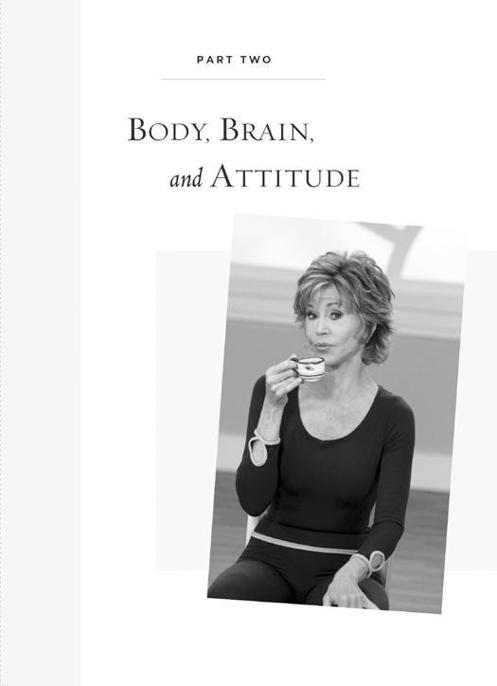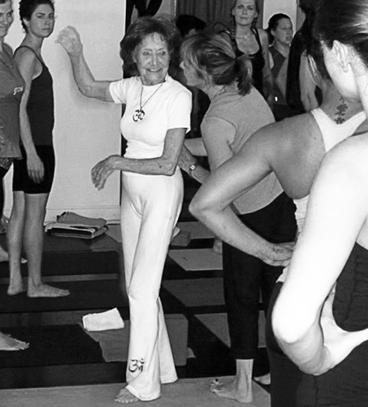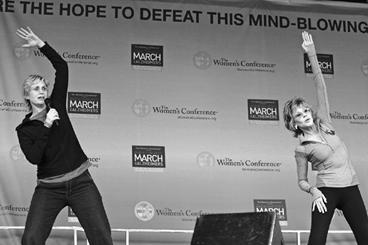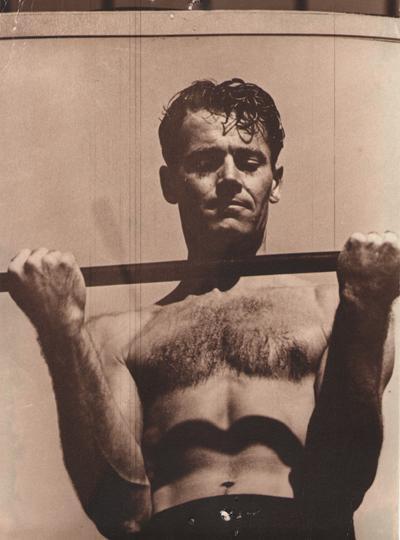Prime Time (15 page)
Authors: Jane Fonda
Tags: #Aging, #Gerontology, #Motion Picture Actors and Actresses - United States, #Social Science, #Rejuvenation, #Aging - Prevention, #Aging - Psychological Aspects, #Motion Picture Actors and Actresses, #General, #Personal Memoirs, #Jane - Health, #Self-Help, #Biography & Autobiography, #Personal Growth, #Fonda

My first big gobbler.
5. EATING A HEALTHY DIET
Never has the phrase “You are what you eat” been truer than in the Third Act. As individuals and as a nation we must pay more attention to reducing the amount of sugar and fats we eat, and to increasing our consumption of fresh fruits and vegetables and complex carbohydrates. There’ll be more on this in
Chapter 7
, “Now More than Ever, You Are What You Eat.”
6. MAINTAINING A HEALTHY, ACTIVE BRAIN THROUGH LEARNING
The current wisdom says that if you regularly do crossword puzzles or Sudoku, your brain will remain healthy. Maybe, if you’re not used to doing them! Certainly your brain is active during those activities. But I have chosen to use the word “learning” here rather than “mental activity” because what brain science tells us today is that to maintain healthy cognitive function, we need to do things we aren’t accustomed to doing—things that make new demands on our minds, force us to make decisions or choices. Furthermore, this learning has to be sustained over time. There will be more about the brain in
Chapter 8
.
I took a yoga class at Tara Stiles’s Strala Yoga studio in New York taught by this ninety-three-year-old instructor.
7. POSITIVITY: ENCOURAGING A POSITIVE ATTITUDE
Almost all the people I have met who are in their nineties or even older seem to have one thing in common: positivity. Scientists at the Stanford Center on Longevity adopted the word “positivity” to express what they, too, have observed. Positivity is an attitude, a way to approach life; it is expressed through humor, gratitude, forgiveness, playfulness, creativeness, and adaptability. I am conscious of this happening to me in my Third Act, which shows that what the experts say is true: We can attain these positive attributes even if we didn’t start off with them! This is one of the aspects of aging that fascinates me the most, and so I have a chapter to come on Positivity—
Chapter 9
.
8. REVIEWING AND REFLECTING ON YOUR LIFE
I was somewhat surprised when I discovered, in the writings of Dr. Robert Butler, that many gerontologists and psychiatrists advocate this for their older patients. In
Chapter 2
, I wrote about how important doing a life review was for me; in
Chapter 10
, I talk more about how to do it.
9. LOVING AND STAYING CONNECTED
Humans are hardwired to interact with others. Having friends, loving partners, and strong social supports have long been demonstrated to have a direct positive effect on health, better cognitive functioning, and longevity. I will explore the various aspects of connectedness—to friends and to spouses or to lovers—in
Chapters 11
through
15
.
10. GENERATIVITY: GIVING OF ONESELF
This term, coined by the social scientist Erik Erikson in his conceptualization of the stages of human development, refers to older people’s responsibility to care for younger generations by giving of oneself—one’s knowledge, experience, time, resources, and values. This can mean mentoring a child, being a coach, reading to your grandchild’s class—and making sure she is in class!—or helping girls and boys in your community or in the developing world. In
Aging Well,
Dr. Vaillant writes that “mastery of Generativity tripled the chances that the decade of the 70s would be for these men and women a time of joy and not of despair.”
5
I discuss this subject in
Chapter 16
, “Generativity: Leaving Footprints.”
11. CARING ABOUT THE BIGGER PICTURE
Moving from a focus on oneself to caring about things greater than oneself makes us whole and strong so we won’t be overwhelmed by the inevitable losses that come in later life. This can mean a focus on your community, your nation, or the planet. You might, building on your experiences, talents, interests … your wounds, even … make a difference. For example, a retired CEO helps set up a microfinance project in Kenya; a former schoolteacher volunteers to teach adults to read; a former UPS employee offers to help working mothers by providing carpool services; a chemical engineer teaches corporations how to become green.
Jane Lynch of
Glee
fame helping me warm up the crowd before Maria Shriver’s march to defeat Alzheimer’s disease, 2010.
FREDERICK M. BROWN/GETTY IMAGES
Chapter 17
, “Ripening the Time,” further develops this concept.
The ingredients that keep us vital, happy, and continuing to grow are there for a majority of us. During our last three decades, as we move from being the “young old” to becoming the “old old,” we can have some of the best years of our lives, and the best news of all is that it is never too late to start making it so. A lot of it
—most
of it—has to do with lifestyle choices we make and how willing we are to live with real intention, instead of just drifting.
Lifestyle Choices
Genes may predispose us to, say, heart disease or arthritis, but the right lifestyle and the right attitude may help us overcome these infirmities. I know older people who are disabled and even ill but who do not
feel
sick. They experience joy and vitality and, in my opinion, exemplify successful aging. Some of the lifestyle and attitudinal choices we can make are best addressed before we enter our Third Acts. But even if we decide to change our ways after sixty, we can still make a big difference in how we age.
In the chapters that follow, I go into more depth about how I and others have incorporated these ingredients into our own lives, and how you might do the same.

CHAPTER 6
The Workout
It’s not that very old people … can exercise because they are healthy … rather, they achieve a healthy old age because they exercise.
—JANE BRODY,
New York Times
HEALTH WRITER
I’ve been screaming at the top of my lungs at my family, “Work out! Work out! Old age is coming!” At some point you will need the strength. Who would have ever thought you would get this old?
—CHER
Dad as a young actor. My only proof that he sometimes worked out.
O
NE DAY, AT AGE FIFTY-NINE, I WAS DRIVING WITH TED TURNER to one of his ranches in Patagonia when we came around a corner and I caught sight of the most magnificent snowcapped mountain I had ever seen, a perfectly symmetrical extinct volcano named Mount Lanin, rising straight up from the flat pampas to twelve thousand feet. Right then I vowed to climb that mountain as a present to myself for my sixtieth birthday.
My stepson Beau Turner said he’d go with me, along with two guides. I trained for several months, bought the needed gear to scale the glacier that composed the top two thousand feet, and off we went. We camped overnight in a blizzard at about ten thousand feet, getting up before dawn in order to make the rest of the ascent and get back down before nightfall. I was totally psyched as we set out in the dark. My heart was pounding with the exertion of hiking through the thigh-deep snow at that altitude, and I felt great about being out ahead of everyone else. One of the guides shouted, “Don’t go too fast, Jane, you’ll sweat,” but I wanted to prove (to myself, mostly) that a sixty-year-old woman still had her mojo. Stupid me. A thousand feet from the top I had to turn around. Just as the guide had warned, the sweaty, damp inner layer of clothing—evidence of my ego—had gotten cold, and my plummeting body temperature put me at risk of hypothermia.
On his way down from the top, Beau picked me up at the mid-mountain campsite and regaled me with descriptions of what it had been like to scale the ice at the summit. I felt like such a failure.
You’d have thought I’d learned my lesson. Right? Wrong! For my seventieth birthday, I wanted to climb to sixteen thousand feet (two thousand feet higher than I had ever been). But I learned that you can’t get that high without getting very cold, and I don’t do cold well.
My boyfriend at the time liked scuba diving and suggested that, instead of going up, I should try going down. Together we went to Ambergris Cay, a small island in the Turks and Caicos chain, where, with a couple of friends, we spent three days training in a pool. We passed the written exam to qualify for scuba diving, and then the time came for the three ocean dives needed for certification. Our guide again stressed the importance of going down slowly and equalizing the air pressure as we went. As I descended, I looked up at my boyfriend, who seemed to be lingering near the surface, and thought, “What a wuss!” I sank down toward the bottom, feeling pretty cocky, until my ears began to hurt; the pain forced me to pass my (much more sensible) boyfriend on my way back up. I lay on the deck of the boat feeling miserable, realizing that for a second time (at least, that I could remember) my need to be competitive had made me go too fast and fail.
I said to myself, “Jane, you’re seventy now. How many times do you have to do something wrong before you learn a lesson? Can’t you finally understand the value of taking time and being deliberate with your actions rather than driven? Promise that you will never make this mistake again.”


